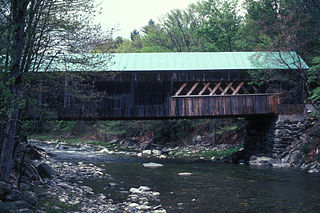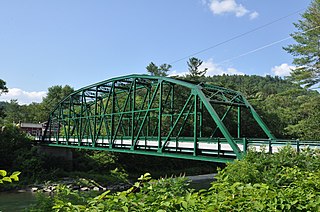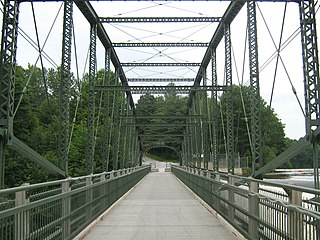
The Mount Orne Bridge is a covered bridge over the Connecticut River between Lancaster, New Hampshire, and Lunenburg, Vermont. It joins Elm Street in South Lancaster with River Road in Lunenburg. Built in 1911, it is one of two Howe truss bridges across the Connecticut River. It was listed on the National Register of Historic Places in 1976.

The Gilead Brook Bridge was an historic bridge which carried Vermont Route 12 across Gilead Brook north of the center of Bethel, Vermont. Built in 1928, it was one of four multi-span Warren deck truss bridges built in the state after extensive flooding in 1927. It was listed on the National Register of Historic Places in 1990. It was replaced in 2019-2020.

The Lamoille River Route 15-A Bridge is a modern steel-and-concrete structure, built in 2013 to carry Vermont Route 15A over the Lamoille River east of Morrisville, Vermont, United States. It was built to replace a metal truss bridge erected there in 1928. The old bridge, of Pratt through truss design, was listed on the National Register of Historic Places in 1991, and was dismantled in 2007.

The Rice Farm Road Bridge is a historic bridge in Dummerston, Vermont. It is an iron Warren through truss, spanning the West River between Vermont Route 30 and Rice Farm Road. Built in 1892, it is one of the state's oldest surviving metal truss bridges. It was listed on the National Register of Historic Places in 1995.

The Round Schoolhouse is a historic school building on Grassy Brook Road in Brookline, Vermont. Built in 1822, it is the oldest brick schoolhouse in Windham County, and further distinctive for its round shape. From 1929 to 1989 it served as Brookline's town hall. It was listed on the National Register of Historic Places in 1977.

The South Newfane Bridge is a historic bridge, carrying Parish Hill Road across the Rock River in the village of South Newfane, Vermont. It is a Pratt through truss span, manufactured from rolled I-beams in 1939 to replace a bridge washed away in flooding. It was listed on the National Register of Historic Places in 1992.

The Williams River Route 5 Bridge is a historic Warren deck truss bridge, carrying U.S. Route 5 (US 5) across the Williams River in Rockingham, Vermont. Built in 1929 and rebuilt in 1971-72, it is one of four bridges of this type and vintage in the state. It was listed on the National Register of Historic Places in 1991.

The Williamsville Covered Bridge is a historic covered bridge, carrying Dover Road over the Rock River in Newfane, Vermont. Probably built in the 1870s, this Town lattice truss bridge is probably the oldest covered bridge in Windham County, and is the only one surviving in the town of Newfane. It was listed on the National Register of Historic Places in 1973.

Bridge 15, also known locally as the River Bridge, spans the White River in Sharon, Vermont. Built in 1928, this multi-span Parker truss bridge is one of a shrinking number of White River crossings of this type. It was listed on the National Register of Historic Places in 2008.

The Bridgewater Corners Bridge carries Vermont Route 100A across the Ottauquechee River in the Bridgewater Corners village of Bridgewater, Vermont. It was built in 1928 by the American Bridge Company, following devastating flooding. It is a single-span Pratt through truss structure, and was listed on the National Register of Historic Places in 1992.

The Gould's Mill Bridge is a historic Baltimore through truss bridge, carrying Paddock Street across the Black River in Springfield, Vermont. The bridge was built by the Boston Bridge Works Company in 1929 after major flooding in 1927, and is one of the state's few examples of a Baltimore truss. It was listed on the National Register of Historic Places in 2006.

The Ottauquechee River Bridge is a steel girder bridge carrying United States Route 5 across the Ottauquechee River in Hartland, Vermont. The bridge replaced a c. 1930 Warren deck truss bridge, built in the wake of Vermont's devastating 1927 floods, and listed on the National Register of Historic Places in 1990.

The Foundry Bridge is a historic Warren pony truss bridge, carrying Foundry Road across the First Branch White River in Tunbridge, Vermont. Built in 1889, it is one of the state's oldest wrought iron bridges, and the only surviving example in the state of work by the Vermont Construction Company, its only local manufacturer of such bridges. It was listed on the National Register of Historic Places in 2007.

The Woodstock Warren Through Truss Bridge was a historic iron bridge that carried Bridges Road across the Ottauquechee River in western Woodstock, Vermont. The bridge was built in 1925, and was a rare example of the state of a double-intersection Warren through truss. The bridge was swept away by flooding caused by Hurricane Irene in 2011; it was listed on the National Register of Historic Places in 1992.

Bridge 9 is a historic Parker through truss bridge, carrying Shawville Road across the Missisquoi River in Sheldon, Vermont. Built in 1928 after Vermont's devastating 1927 floods, it is one of the few surviving Parker truss bridges on the Missisquoi. It was listed on the National Register of Historic Places in 2007.

Bridge 12 is a historic Parker through truss bridge, carrying Boston Post Road across the Missisquoi River in Enosburg, Vermont. Built in 1929 in the wake of Vermont's devastating 1927 floods, it is one a shrinking number of surviving truss bridges on the river. It was listed on the National Register of Historic Places in 2007.

The Douglas & Jarvis Patent Parabolic Truss Iron Bridge is a historic bridge across the Missisquoi River in Highgate, Vermont. Located at the end of Mill Hill Road, it is at 215 feet (66 m) one of the longest bridges of its type in the northeastern United States. It was built in 1887, and was listed on the National Register of Historic Places in 1974.

The Middlesex–Winooski River Bridge is a steel girder bridge carrying U.S. Route 2 (US 2) across the Winooski River in a rural area on the town line between Moretown and Middlesex, Vermont. The two-span bridge was built in 2010, replacing a 1928 three-span Pratt through truss, which was listed on the National Register of Historic Places in 1991.

The Railroad Street Bridge is a historic Pratt through truss bridge, carrying Railroad Street across the Lamoille River in Johnson, Vermont. It was built in 1928, after the state's devastating 1927 floods, and is one of its few surviving Pratt through truss bridges. It was listed on the National Register of Historic Places in 2007 as Bridge 6.

The Chelsea Street Bridge is a bridge in South Royalton, Vermont, spanning over the White River. The original bridge was constructed in 1848, followed by several replacements. The current bridge was completed in 2002.























